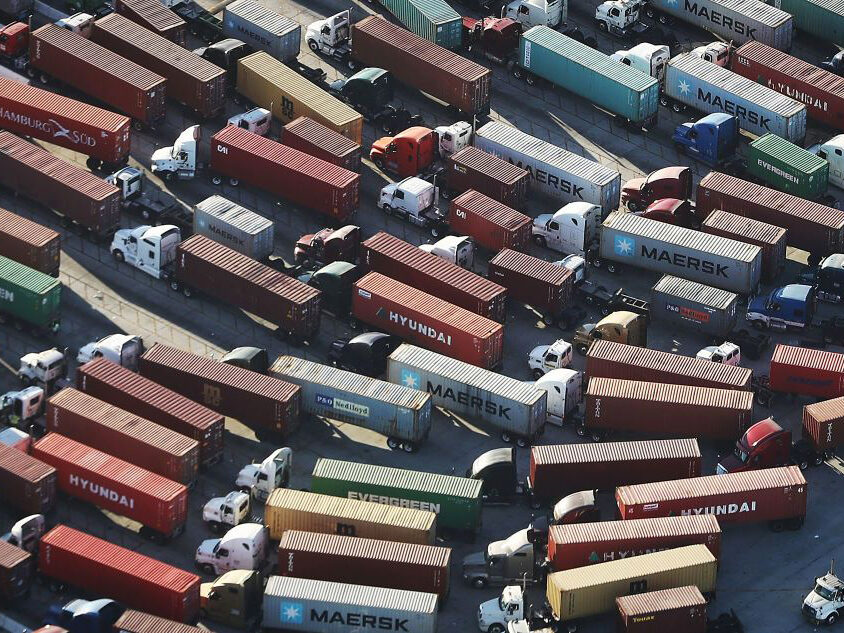
Visit Our Sponsors |
|
|
|
|
|
|
|
|
|
|
|
|
|
|
|
|
|
|
|
|
|
|
|
|
|
|
|
|
|
|
|
|
|
|
|
|
|
|
|
|
|
|
|
|
|
|
|
|
|
|
|
|
|
|
|
|
|
|
|
|
|
|
|
|
|
|
|
|

Restrictions on empty-container returns at major ports are the top issue that needs fixing to help ease U.S. supply chain bottlenecks, the head of the Harbor Trucking Association said, adding that true round-the-clock operations aren’t yet in place.
“We are drowning in empty containers here in this harbor and in our trucking yards,” HTA Chief Executive Officer Matt Schrap said in an interview last week at the Port of Los Angeles. “Right now, we’re literally storing thousands of empty containers, thousands of chassis that we can’t use to move these imports.”
According to port regulations, trucking companies have to make an appointment to pick up a container off the dock, Schrap said. Trucks need a chassis — which are hooked to the vehicles — to collect the import, but unless they bring an empty container to free up the chassis, they’re unable to move the import, Schrap said.
The U.S. supply chain has strained under record-breaking demand because of growing e-commerce, worker and truck-chassis shortages and a shift to material goods as Americans avoided travel and social outings over the course of the pandemic.
Read more: Vanishing Ships Underscore Supply Woe: Crisis Peak Is a Mirage
The Biden administration has been under pressure to clear logjams and ease inflationary pressures as consumers begin their holiday shopping. Its moves have included brokering agreements to shift to round-the-clock operations at the ports of Los Angeles and Long Beach — the biggest gateway for imports — and pledges from retailers to expand their own shipping.
Schrap said it’s a shortage of productivity and efficiency — not drivers and trucks — that’s causing the supply chain issues, and that the problems with empty containers are “becoming worse.”
“We have folks who are making one turn per day when they will be doing two to three turns in a normal scenario,” he said. “A lot of that has to do with chassis availability, congestion behind the gates, and these empty containers.”
Facing high import volumes, the port of Los Angeles in October announced a ramp-up to 24-7 operations to help ease the congestion that experts say could continue well into next year.
The harbor isn’t yet operating around the clock, Schrap said.
“The 24-7 concept is something that you open up a third shift from 3 a.m to 7 or 8 a.m., where you are able to go in and pick up containers — but the same type of empty-container restrictions, chassis restrictions prevent the use of that truck gate,” he said. “Longshore can work 24-7 rail side, but we do not have 24-7 gates across the harbor.”
Port of Los Angeles Executive Director Gene Seroka told Bloomberg Television Friday that the number of aging containers sitting on the docks awaiting collection had dropped 60% since it announced plans to charge penalties on Oct. 25. It hasn’t implemented the so-called dwell fees.
Schrap said there are more than 115,000 empty containers in the Los Angeles port waiting to return to their point of origin.
“That’s on top of another over 10,000 containers that are out in the wild, so to speak, across the Southwest United States, in our truck yards on the streets, grounded, sitting on chassis all over the place,” he said. “For us, it’s gotten a little more strained, to be honest.”
The administration is doing a “great job” of getting ocean carriers, terminal operators, truckers, government officials around the table, a move that Schrap said is unprecedented.
RELATED CONTENT
RELATED VIDEOS
Timely, incisive articles delivered directly to your inbox.

